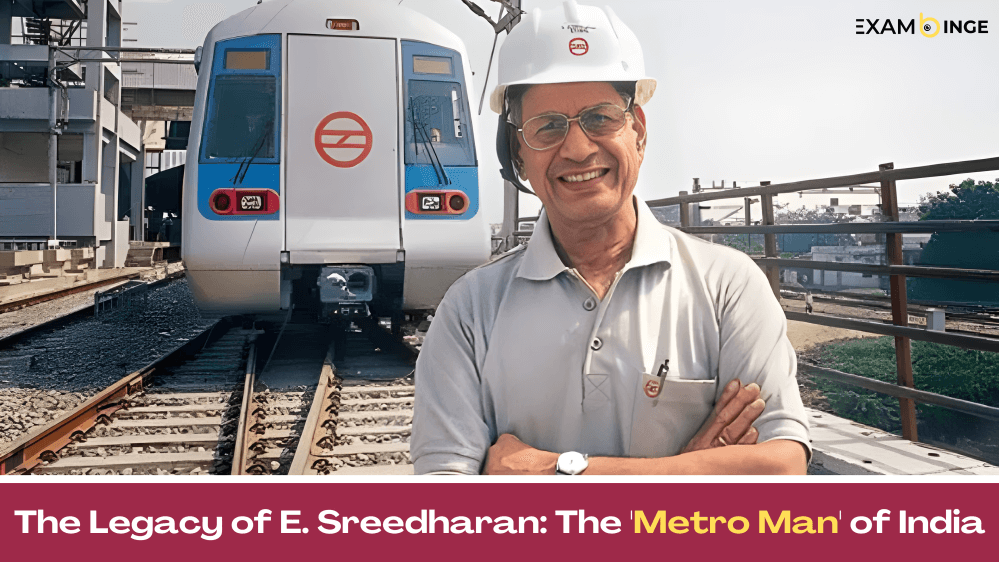India, a country known for its cultural diversity and rapid urbanization, has witnessed transformative changes in its infrastructure over the years. Among the key contributors to this transformation is E. Sreedharan, affectionately called the Metro Man of India. His visionary leadership and dedication to public service have left an indelible mark on the nation’s transportation landscape.
Early Life and Career of E. Sreedharan
E. Sreedharan was born on 12th June 1932 in Palakkad, Kerala. A bright and determined student, he graduated as a civil engineer from the Government Engineering College, Kakinada (now JNTU Kakinada). His journey into the world of engineering and public service began with his role as a lecturer before joining the Indian Railways as an engineer in 1954. Little did anyone know that this soft-spoken man would later redefine urban mobility in India.
The Turning Point: Pamban Bridge Restoration
One of the early milestones in E. Sreedharan’s career was his leadership in restoring the Pamban Bridge, a vital railway bridge connecting Rameswaram to mainland India. After it was damaged by a cyclone in 1964, Sreedharan and his team completed its restoration in just 46 days, against the stipulated six months. This achievement not only showcased his engineering brilliance but also his ability to manage time-sensitive projects effectively.
Revolutionizing Rail Transport: Konkan Railway
The Konkan Railway Project, spanning 760 km along the challenging terrain of India’s western coast, was a monumental task. This region posed geographical and environmental challenges that seemed insurmountable. However, under Sreedharan’s leadership, the project was completed in record time and within budget. This feat established him as a pioneer in infrastructure development and demonstrated his knack for balancing innovation with practicality.
The Birth of the Metro Man
E. Sreedharan earned the title of Metro Man during his tenure as the Managing Director of the Delhi Metro Rail Corporation (DMRC). The Delhi Metro was India’s first modern urban mass transit system, and its success became a benchmark for infrastructure projects across the country. Some key highlights of his tenure include:
- Timely Completion: Despite the complexities of urban construction, the Delhi Metro’s initial phases were completed ahead of schedule.
- Efficiency and Transparency: Sreedharan ensured that the project remained free from corruption, a rare feat in large-scale infrastructure projects in India.
- Technology and Sustainability: The Delhi Metro introduced advanced technologies and prioritized environmental sustainability, earning international acclaim.
Beyond Delhi: Expanding the Metro Network
E. Sreedharan’s expertise was sought for metro projects across various Indian cities, including Kochi, Bengaluru, and Lucknow. His work set a standard for urban transport systems, making metro rail an integral part of India’s urban planning.
Leadership Style and Principles
Sreedharan’s leadership style was rooted in discipline, integrity, and a commitment to excellence. He was known for his hands-on approach, meticulous planning, and ability to inspire his team. His mantra of adhering to deadlines and ensuring accountability became a cornerstone of his projects’ success.
Awards and Recognition
E. Sreedharan’s contributions have been recognized both nationally and internationally. Some of the accolades he has received include:
- Padma Shri (2001): For his exceptional contribution to Indian engineering.
- Padma Vibhushan (2008): India’s second-highest civilian award, for his transformative impact on the nation’s infrastructure.
- Chevalier de la Légion d’honneur (2005): France’s highest civilian award.
The Sreedharan Legacy
Sreedharan retired in 2011 but continues to inspire generations of engineers and leaders. His work has shown that transparency, efficiency, and ethical practices are achievable even in complex and large-scale projects. He has set a precedent for how public service and infrastructure development should be approached in India.
Lessons from E. Sreedharan’s Life
E. Sreedharan’s journey is not just about building metros and railways; it is about building trust, efficiency, and a vision for a better India. His life teaches us:
- Discipline is Key: Success in any field requires dedication and adherence to principles.
- Lead by Example: A leader who works alongside their team earns respect and ensures quality.
- Ethics Matter: Integrity is the foundation of long-term success.
- Innovation and Adaptability: Embracing new technologies and methods can solve even the most daunting challenges.
Conclusion
E. Sreedharan’s legacy as The Metro Man of India is a testament to what one individual’s vision and dedication can achieve. His contributions have not only revolutionized urban transport but also inspired a generation to dream big and work tirelessly to realize those dreams. As India’s cities continue to grow, the blueprint laid by Sreedharan will remain a guiding light for future infrastructure projects.
E. Sreedharan’s story is a reminder that with discipline, integrity, and a clear vision, we can overcome challenges and build a future that serves generations to come.




